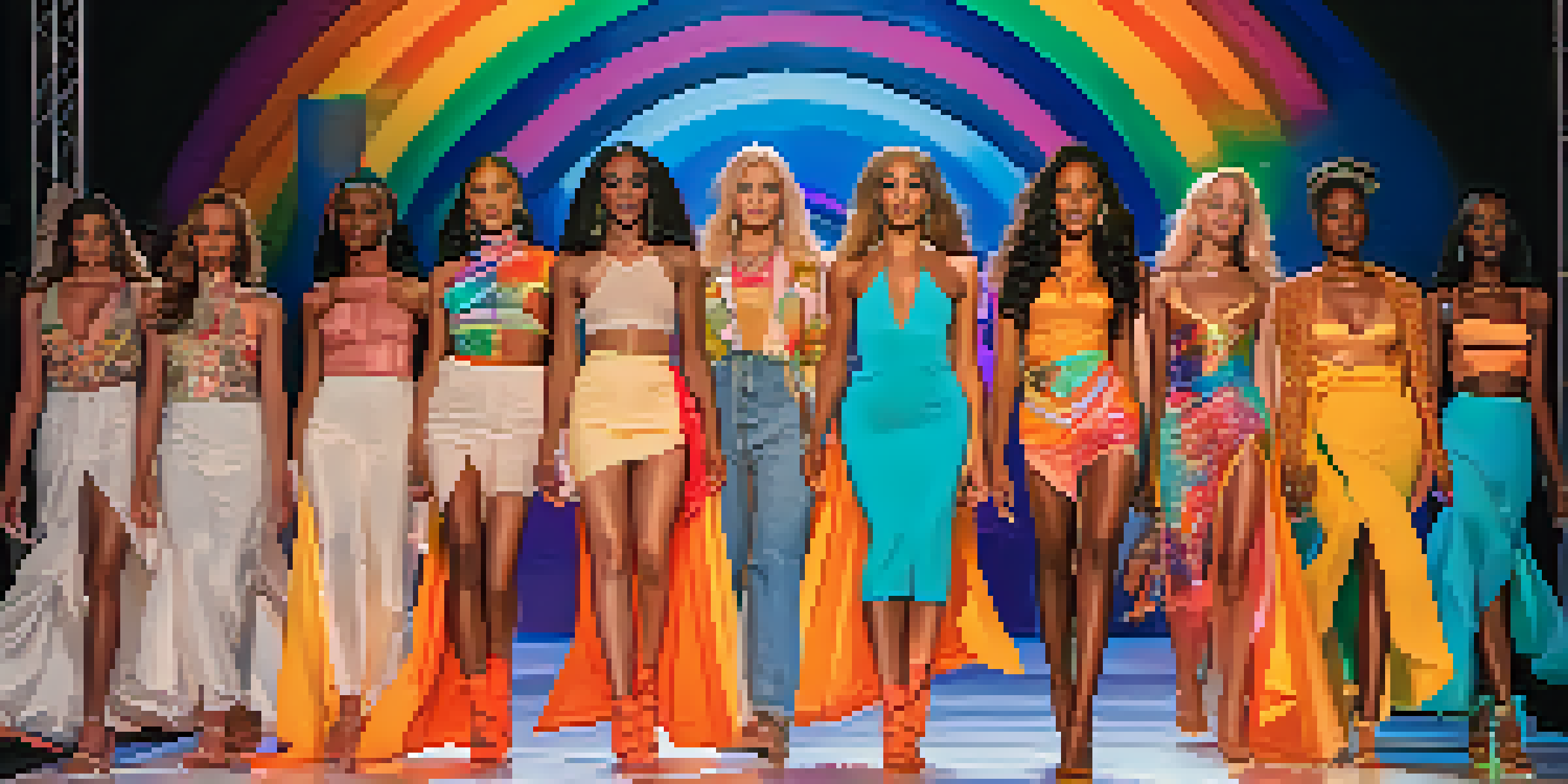Trans Inclusivity in Fashion: A Journey Towards Representation

Understanding Trans Inclusivity in Fashion
Trans inclusivity in fashion refers to the acceptance and representation of transgender individuals in the fashion industry. This concept emphasizes the importance of creating spaces where trans voices and identities are celebrated rather than marginalized. By embracing inclusivity, fashion can reflect the diversity of society and promote a more authentic representation of beauty.
Fashion is not something that exists in dresses only. Fashion is in the sky, in the street, fashion has to do with ideas, the way we live, what is happening.
Historically, the fashion industry has often overlooked trans individuals, perpetuating a narrow definition of beauty that excludes many. However, the tides are changing as more brands recognize the need for diverse representation in their campaigns and collections. This shift not only empowers trans individuals but also challenges outdated stereotypes and promotes a more expansive view of fashion.
Trans inclusivity is not just a trend; it's a vital aspect of creating a more equitable industry. When fashion brands prioritize inclusivity, they contribute to a culture that respects and validates all identities, fostering a sense of belonging. As consumers increasingly demand authenticity, brands that embrace trans inclusivity are not only doing the right thing but also tapping into a growing market.
The Evolution of Representation in Fashion
The journey towards trans inclusivity in fashion has been gradual, marked by both progress and setbacks. In the past, trans representation was often limited to tokenism, where a single trans model might be featured without any real commitment to inclusivity. This approach fell short of genuinely representing the diverse experiences within the trans community.

Over the years, we've seen significant milestones that have reshaped the narrative. Pioneering figures, such as Andreja Pejić and Laverne Cox, have brought trans visibility to the forefront of fashion and media. Their success stories have opened doors for many others, showing that trans individuals can thrive and excel in the fashion space.
Fashion Embraces Trans Inclusivity
The fashion industry is increasingly recognizing the importance of representing trans individuals, leading to a more authentic reflection of diverse identities.
Today, brands are increasingly featuring trans models in their campaigns and runway shows, signaling a shift towards more authentic representation. This evolution is crucial not only for visibility but also for inspiring future generations of trans individuals who aspire to see themselves reflected in the fashion world.
Challenges Faced by Trans Individuals in Fashion
Despite the progress made, trans individuals still face significant challenges in the fashion industry. Issues such as discrimination, lack of access to opportunities, and the pressure to conform to narrow beauty standards continue to persist. These barriers can make it difficult for trans individuals to find their place within the industry.
We are all born with creativity. It’s just that we’re taught to suppress it as we grow up. We are taught to conform, to fit in, and to be like everyone else.
Moreover, many trans models encounter skepticism and bias from brands and casting directors. This can lead to missed opportunities and a lack of representation on runways and in advertisements. The need for systemic change is evident, as the industry must actively work to dismantle these barriers and create a more supportive environment.
It’s essential for brands to not only include trans individuals in their campaigns but also to create policies and practices that promote equity and inclusivity. By fostering an environment where trans identities are respected and celebrated, the fashion industry can become a more welcoming space for everyone.
The Role of Fashion Brands in Promoting Inclusivity
Fashion brands play a crucial role in shaping societal perceptions of gender and identity. By choosing to feature trans individuals in their marketing and collections, they can challenge stereotypes and promote a more inclusive narrative. Brands that authentically represent diversity often resonate more with consumers, leading to increased loyalty and engagement.
Many brands are now recognizing the importance of hiring trans individuals not just as models, but also in creative and decision-making roles. This shift ensures that the voices of the trans community are heard and valued, which can lead to more authentic and relatable fashion offerings. Inclusivity in hiring practices is a vital step towards a more equitable industry.
Challenges Persist for Trans Models
Despite progress, trans individuals still face discrimination and barriers that hinder their full participation in the fashion industry.
Additionally, collaborations with trans activists and designers can further amplify marginalized voices. By partnering with individuals who have lived experiences, brands can create collections that genuinely reflect the diversity of the community they aim to serve. This approach not only enriches the fashion landscape but also fosters a sense of empowerment and representation.
Consumer Demand for Trans Representation in Fashion
As awareness around trans issues grows, so does consumer demand for representation in fashion. Shoppers are increasingly seeking brands that align with their values, prioritizing inclusivity and diversity. This shift in consumer behavior has prompted many brands to reconsider their marketing strategies and product offerings.
Social media has played a significant role in amplifying this demand, allowing trans voices to share their experiences and advocate for change. Platforms like Instagram and TikTok have become powerful tools for raising awareness and fostering community among those who champion inclusivity. Brands that listen to these voices are better positioned to connect with their audience and build lasting relationships.
Ultimately, consumer demand for trans representation is reshaping the fashion landscape. Brands that embrace this change not only contribute to a more equitable industry but also benefit from a loyal customer base that appreciates their commitment to social justice and inclusivity.
The Impact of Social Media on Trans Inclusivity
Social media has emerged as a powerful catalyst for change in the fashion industry, particularly regarding trans inclusivity. Platforms like Instagram, Twitter, and TikTok provide a space for trans individuals to share their stories, showcase their style, and challenge conventional beauty standards. This grassroots movement has helped elevate trans voices and visibility in a way that traditional media often fails to do.
Through social media, trans activists and influencers can hold brands accountable for their representation practices. They can highlight instances of tokenism or lack of diversity, urging brands to do better. This increased scrutiny encourages fashion companies to be more mindful of their marketing strategies and to genuinely engage with the trans community.
Consumer Demand Drives Change
Growing consumer demand for inclusivity and representation is prompting brands to rethink their marketing strategies and embrace diverse identities.
Moreover, social media allows for rapid feedback and engagement, fostering a dialogue between consumers and brands. As a result, many fashion companies are adapting their approaches to align with the values of their audience, leading to more inclusive and representative campaigns. This dynamic interaction is reshaping the industry and paving the way for a more inclusive future.
Looking Ahead: The Future of Trans Inclusivity in Fashion
The future of trans inclusivity in fashion is bright, with many signs pointing towards continued progress. As more brands recognize the importance of diverse representation, we can expect to see an increase in trans models, designers, and influencers shaping the industry. This shift will not only enrich the fashion landscape but also inspire future generations to embrace their identities.
Education and awareness are key components in driving this change. As fashion schools and industry professionals become more informed about trans issues, they can implement practices that promote inclusivity from the ground up. By fostering an environment of understanding and respect, the industry can create a lasting impact on the representation of trans individuals.

Ultimately, the journey towards trans inclusivity in fashion is an ongoing one. While significant strides have been made, there's still much work to be done. By continuing to advocate for representation and equity, we can ensure that the fashion industry reflects the beautiful diversity of our world.